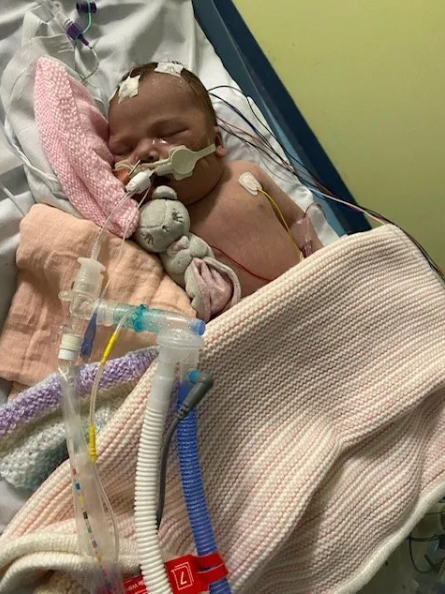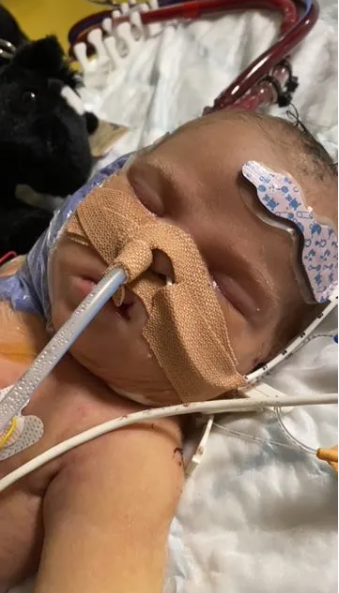Pulmonary Atresia: Ivy’s Story of Hope and Heart

When your baby is born, you expect sleepless nights, soft cries, and sweet cuddles — not ambulances, surgeries, and the fear of losing them.
For Bernice and her family, their world changed just four days after welcoming their perfect baby girl, Ivy.
This is their story — one of heartbreak, strength, and the power of hope.
(The photos in this story were taken by and belong to the author, capturing their family’s personal journey.)
The Beginning: A Perfect Baby Girl
Our daughter, Ivy, was born in June 2021. She looked perfect — tiny fingers, bright eyes, and a soft heartbeat that filled our hearts with love.
But soon after birth, we began to notice little things that didn’t feel right. Ivy was often sleepy, and feeding her became difficult. Each time we voiced our concerns, we were told she was fine.
We wanted to believe it.
We wanted to believe she was okay.

Four Days Old — The Day Everything Changed
When Ivy was just four days old, she became unusually drowsy and stopped feeding altogether. My instincts told me something was terribly wrong.
I called 999.
By the time the ambulance arrived, Ivy’s oxygen levels had dropped to just 40%.
We rushed to the hospital under blue lights. On the way, Ivy’s heart stopped. The paramedics brought her back — but as soon as we reached the hospital doors, she went into cardiac arrest again.
For 45 long minutes, doctors and nurses fought to save her.
And somehow, miraculously, they did.
Later, we learned the truth: Ivy had a rare congenital heart defect called pulmonary atresia with intact ventricular septum (PA/IVS) — a condition where her pulmonary valve didn’t form properly, blocking blood flow from her heart to her lungs.
Life in the Intensive Care Unit
Ivy was immediately transferred to the Pediatric Intensive Care Unit (PICU).
Her tiny body was fighting for survival. She was in multiple organ failure, and doctors feared she might have suffered brain damage.
We waited anxiously for her CT scan results — praying for good news.
And then, a miracle: her brain was unharmed.
That small victory gave us the courage to keep believing.

The First Surgery
At nearly one month old, Ivy underwent her first open-heart surgery. Doctors inserted a small balloon catheter to help open her heart and allow blood to flow.
But the surgery didn’t go as planned.
Her heart couldn’t handle the procedure, and the team had to stop.
We were told they’d try again when she was stable. Days passed. Ivy grew weaker. Machines hummed and beeped around her, each one keeping her alive.
ECMO: A Lifeline
A few days later, Ivy’s condition deteriorated rapidly. Her body couldn’t take any more.
Doctors decided to put her on ECMO (Extracorporeal Membrane Oxygenation) — a life-support system that allows the heart and lungs to rest.
It was terrifying to see her connected to so many tubes, but ECMO gave her body the break it needed.
That same week, surgeons decided to try one more operation.
This time, the surgery worked.
The valve was opened successfully, and Ivy’s blood flow improved immediately.
The next day, she was weaned off ECMO.
Her little heart was beating on its own again.

Eighty-Nine Days in Hospital
The weeks that followed were a blur of tests, treatments, and small victories.
Ivy remained in the hospital for 89 days — nearly three months of watching her grow stronger, one breath at a time.
Eventually, she was stable enough to transfer to our local hospital, where she stayed for a few more weeks before finally coming home.
After almost four months in hospitals, our baby girl was back in our arms — where she belonged.
We will never forget the care, compassion, and skill of the doctors and nurses who saved her life.
They didn’t just heal her heart — they healed ours too.
Reflections and Gratitude
If Ivy’s condition had been detected during pregnancy or right after birth, her journey might have been easier.
We might have avoided those terrifying moments — the ambulance ride, the cardiac arrests, the endless nights in PICU.
That’s why we’re deeply grateful to charities like Tiny Tickers, who raise awareness about congenital heart defects (CHD) and help improve early detection rates.
Their work can save lives — just like Ivy’s.

Ivy’s Update – 2024
Fast forward to 2024.
Ivy is three years old — full of life, laughter, and determination.
Her check-ups show that her heart valve is functioning well, and she continues to grow stronger every day.
Sometimes, I look at her running, laughing, and playing, and it’s hard to believe how close we came to losing her.
If her condition had been found during pregnancy, we might have been spared the trauma. But at the same time, her story has made us more grateful for every single day.

Ivy’s Update – 2025
Today, Ivy is four years old — and thriving.
She’s started school, and she’s doing everything we once feared she’d never be able to do.
She still has cardiology check-ups every seven months, but her latest echocardiogram shows that her valve continues to work perfectly.
Since being diagnosed at four days old, Ivy has grown into a fearless little warrior — confident, independent, and full of energy.
She rides her pony, Sooty, and even takes part in small riding competitions.
She also loves gymnastics and swimming.
Every time I see her chasing bubbles or giggling with friends, I’m reminded of how far she’s come — and how lucky we are.

A Family’s Endless Gratitude
Every day, we’re thankful for Ivy — our miracle girl.
She reminds us that life is fragile, precious, and full of second chances.
Even though she’s healthy now, the pain of those early days never fully fades.
But instead of fear, it’s gratitude that fills our hearts.
We celebrate every birthday, every milestone, every laugh.
We watch her grow, knowing she carries a scar not of weakness — but of extraordinary courage.
Ivy’s story is one of survival, strength, and hope.
She’s living proof that even the smallest hearts can fight the biggest battles — and win.











